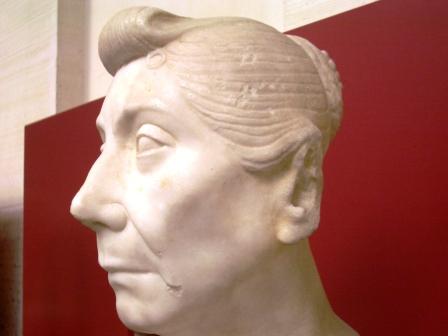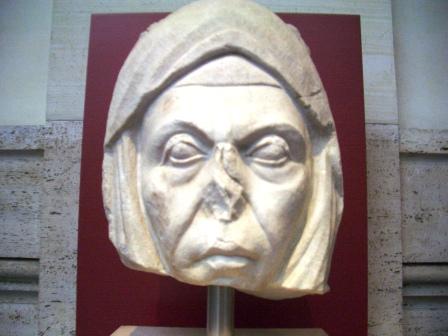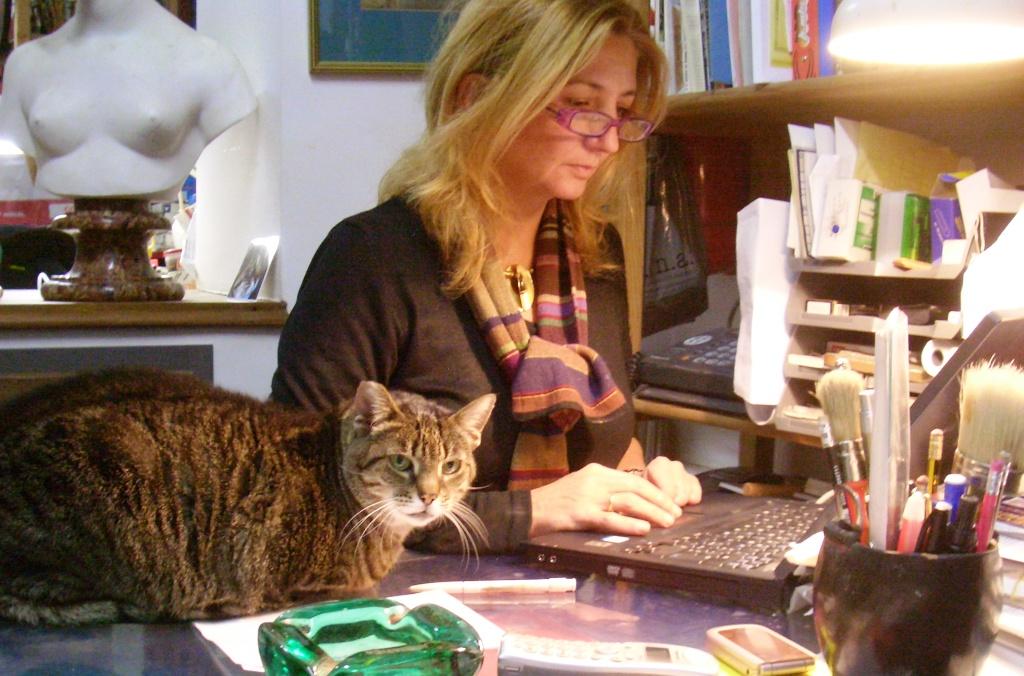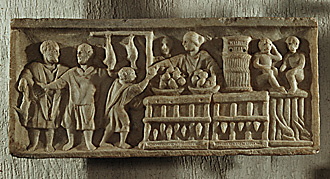|
|
| |
|
|
|

Bust of Ideal Good Wife.
Palazzo Massimo, National Museums of
Rome, Rome. Note her severe hairstyle; it was popularized by the Empress Livia, 1st c AD.
Highlights
* The aristocratic wife in ancient Rome was expected to run an excellent
household. The household was the center of both business and family
life.
* Aristocratic Roman women could go out in public, unlike their Greek
counterparts.
* Women who worked were not at all admired or esteemed.
* Aristocratic women could, through others, buy, sell, and manage
property and commercial enterprises.
* Travel except to one's summer villa was rare for an aristocratic
woman.
|
|
Women's
Daily Life and Work in Ancient Rome
The Good Wife
Roman writers tell us a good Roman wife preferred to stay
indoors, at home.
There she could devote her time to
the household, symbolized by a devotion to spinning wool. But then, the
writers
were all males.
The good wife ran an excellent household, the "domus."
The household was extremely important in Roman ideology.
It was the aristocratic husband's office. Here he met each morning with his "clients."
The clients entered the house into the atrium, a large public room meant
to show off the family. It contained the ancestral shrines, the
household gods, perhaps the marriage bed, and the loom for spinning and
weaving.
The household was also the home: Romans ate here, and the children
received their literary and moral education at home.
Above all, the good wife must stay in the shadow of her husband.
|
|
|
|
|
|
|
|
|
Daily life of an
aristocratic woman
Compared to their counterparts in ancient
Greece, Roman wives of the upper classes were
shocking in their visibility in public.
Married women appeared in public, with their
husbands, or with a retinue of attendants.
They went
shopping, attended festivals, sacrifices, games, and
entertainment. They acted as hostesses and dined
out. They attended women-only social events.
Aristocratic women spent a great deal of time on
personal grooming and beauty preparations.
For more on hairstyles :
Glorious Roman Hairstyle Photos
The good wife supervised the household and made sure
her children were well-educated in Latin and in
Greek culture, and steeped in the moral values
of ancient Rome and the family's ancestors.
If the
husband was away on military or political service, a good wife
was expected to keep her husband fully
informed on political life in Rome via letters.
|
|

Elderly
"matrona."
Marble bust,
1st c BC, National Museum of Rome, Palazzo
Massimo.
A matrona was the ideal Roman woman:
She was married and respectable. She represented
modesty, restraint, graciousness, a sense of honor
and concern for family reputation. The most venerated
"matrona" was the elderly
patrician widow who had successfully raised children
and advanced the family's name through high moral
standards.
|
| |
|
|
|
|
|
|
|
|
|
|
Work in Ancient Rome
Today, we admire
working women, but in Roman times, not so.
In an economy of scarcity, idleness
could not be tolerated. All women worked. The elite women ran their
elite households; all the other women worked with
their hands.
Women in Small Businesses
Free(d) women
might work with their husbands in wool
works, food shops, and the grocery businesses. Reliefs found in old
Ostia and in Pompeii show many such working occupations.
Still, women who worked with their hands were not
held in high esteem. In Roman law under the Emperor Augustus, adultery
began to carry heavy penalties. But it was not considered
adultery for the male if he
had sexual relations "with women who have charge of any business or
shop."
These women didn't matter. |
|

Interior Designer, Rome, 2011.

Woman in butcher
shop, presumably working with her husband.
Relief,
Ostia, Italy.
Photo courtesy Eric
Lessing. |
| |
|
|
| |
|
|
| |
|
|
Women in
"the professions"
Women might
be priestesses outside the Vestal Virgin group, especially in the later
Roman era.
Individually, women worked as midwives, wet nurses,
and nannies. They might be hairdressers or seamstresses in an elite household.
Some Roman women were physicians, but generally Greek males dominated
this field. Highly educated Greeks arrived in droves as slaves after Rome's military successes over Greece in the 3rd
c. BC. Most were later
freed.
Women in the prostitution or acting realms were
considered particularly lowly. Their options, especially for marriage,
were more constrained than for most other Roman women. |
|

Priestess?
Bust of a young woman, possibly a priestess judging from her diadem and hairstyle. Later Roman
era. Marble. Art Institute of Chicago. |
| |
|
|
|
Updated 04-August-2015. You may
contact me, Nancy Padgett, at
NJPadgett@gmail.com |
|
|
|
|